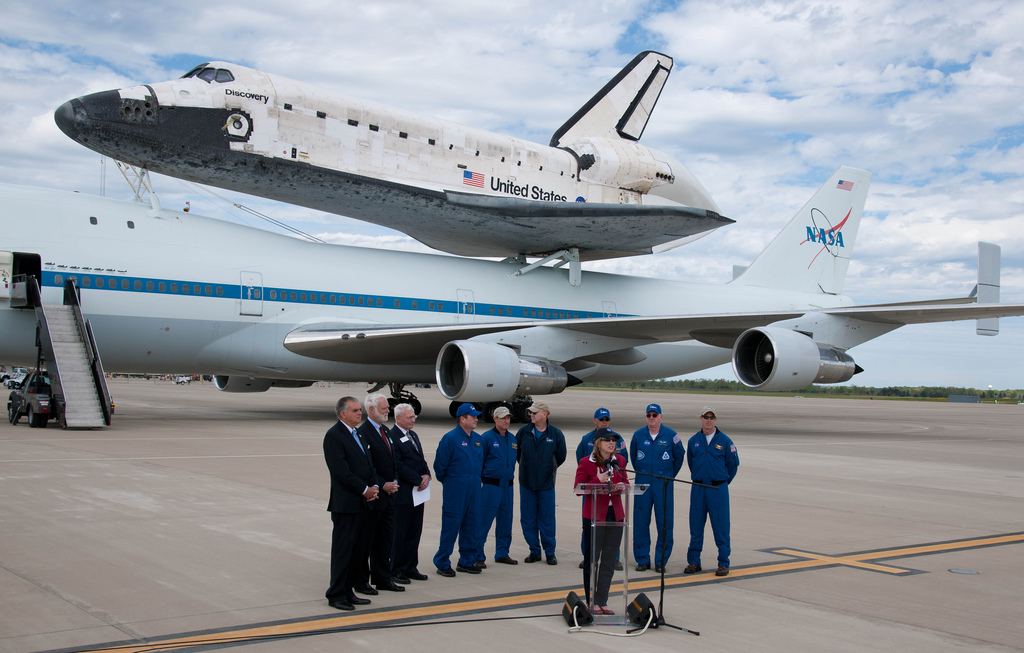
The space shuttle Discovery's flying days may be over, but a set of stunning new panoramic photos ensures that the space plane will remain fresh in people's minds for years to come.
Discovery made its last flight Tuesday (April 17), riding on the back of a modified 747 jet from NASA's Kennedy Space Center in Florida to Washington, D.C., where it will soon take up residence at the Smithsonian Institution's National Air and Space Museum.
The museum plans to seal the shuttle up, so visitors won't be able to take Discovery's controls or peer into the astronauts' oven. But now anyone with a computer can get a great look inside NASA's shuttle fleet leader, which flew 39 space missions and spent 365 days in Earth orbit during its long career.
Photographers working with National Geographic took a series of high-resolution pictures of Discovery's interior, then stitched them together into a huge, crisp and zoomable panorama using software called GigaPan. GigaPan is based on technology developed for NASA's Mars rovers Spirit and Opportunity.
One such panorama, created by photographer Jon Brack, shows Discovery's mid-deck, where astronauts slept, prepared their meals and carried out some experiments, among other activities. [Photos: Shuttle Discovery's Final Voyage (to Museum)]
Viewers can zoom in to get close-up looks at various parts of the mid-deck, including the airlock hatch, the galley and the "Sally Ride Curtain" — a privacy drape separating the toilet from the rest of the mid-deck. It was set up at the request of NASA astronaut Sally Ride, who became the first American woman in space on the shuttle Challenger's STS-7 mission in 1983.
The photographers also created gigapan images of Discovery's flight deck, payload bay, underbelly and various other shuttle sectors and components; check them out in this National Geographic story or at the magazine's new "Spaceflight HD" hub.
Get the Space.com Newsletter
Breaking space news, the latest updates on rocket launches, skywatching events and more!
NASA retired its space shuttle fleet in July 2011 after 30 years of service. The three remaining space-flown orbiters will spend the rest of their days as museum showpieces; the shuttle Endeavour is headed to the California Science Center in Los Angeles, while Atlantis will take up residence at the Kennedy Space Center Visitors Complex in Florida.
Enterprise, a shuttle prototype that never reached space, had been at the Smithsonian but will head to New York City's Intrepid Sea, Air and Space Museum to make room for Discovery.
NASA and its prime shuttle-servicing contractor, United Space Alliance, allowed photographers aboard all three shuttles after their final space missions, to help give future generations a more complete picture of the iconic space planes. National Geographic's team also created zoomable panoramas of Atlantis and Endeavour, the magazine reported.
A total of five NASA space shuttles reached orbit, but two of them were lost along with their entire seven-astronaut crews in the line of duty. The shuttle Challenger exploded shortly after liftoff in 1986, while Columbia broke apart during re-entry to Earth's atmosphere in 2003.
You can follow SPACE.com senior writer Mike Wall on Twitter: @michaeldwall. Follow SPACE.com for the latest in space science and exploration news on Twitter @Spacedotcom and on Facebook.
Join our Space Forums to keep talking space on the latest missions, night sky and more! And if you have a news tip, correction or comment, let us know at: community@space.com.

Michael Wall is a Senior Space Writer with Space.com and joined the team in 2010. He primarily covers exoplanets, spaceflight and military space, but has been known to dabble in the space art beat. His book about the search for alien life, "Out There," was published on Nov. 13, 2018. Before becoming a science writer, Michael worked as a herpetologist and wildlife biologist. He has a Ph.D. in evolutionary biology from the University of Sydney, Australia, a bachelor's degree from the University of Arizona, and a graduate certificate in science writing from the University of California, Santa Cruz. To find out what his latest project is, you can follow Michael on Twitter.









